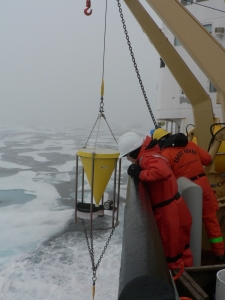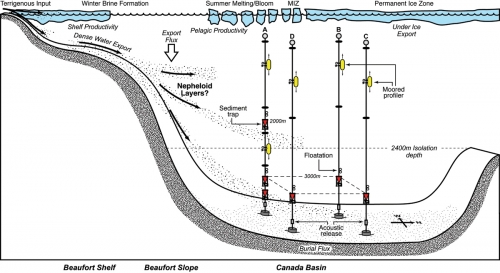Introduction
Mobilization of carbon from permafrost soils and a reduction in sea-ice cover are two major manifestations of a warming Arctic. Both have the potential to perturb the Arctic Ocean carbon cycle, with attendant ramifications for the marine ecosystems and human populations that depend on them. Despite evidence that rapid changes are underway, our understanding of current biogeochemical processes within the central Arctic Ocean, and when and how they will respond in the future, remains limited. This lack of understanding hinders our ability to predict whether the Arctic will serve as a net carbon dioxide (CO2) source or sink for atmospheric carbon as well as how coastal and pelagic ecosystems will be perturbed in response to climate change.

Funded by the NSF Arctic Natural Sciences (ANS) Program, research scientists Steve Manganini of Woods Hole Oceanographic Institution (WHOI); Tim Eglinton of WHOI and the Eidgenossische Technische Hochshule (ETH) in Zürich, Switzerland; and Roger Francois of the University of British Columbia, Canada are seeking to bridge this information gap through examination of biogeochemical fluxes in seasonally and permanently ice-covered regions of the Canada Basin. In particular, they are investigating the nature and effectiveness of the "biological pump" in removing carbon from the surface ocean and sequestering it in deep waters and underlying sediments. The biological pump is the process by which organic matter—produced as a result of photosynthetic carbon fixation by phytoplankton—is exported vertically to depth on settling particles. The research team is addressing two specific questions in this context:
- How do biogeochemical fluxes to the deep Arctic Ocean vary in response to sea-ice and hydrographic conditions?
- What are the sources of particulate organic carbon, and what are the mechanisms of supply to the deep Arctic Ocean?
Investigation of Carbon Fluxes in the Canada Basin
In collaboration with a team of U.S., Canadian, and Japanese research scientists, Eglinton, Manganini, and Francois deployed time-series sediment traps under seasonally and permanently ice-covered regions of the Canada Basin as part of the ongoing Beaufort Gyre Exploration Project (http://www.whoi.edu/beaufortgyre/). The traps are integrated into bottom-tethered moorings and configured to intercept particles reaching the basin interior at depths of 2,000 meters and greater. Despite the extreme challenges of mooring deployment and recovery in ice-laden waters, several years of hydrographic data and sediment trap samples were recovered. Multiple geochemical tracer approaches, including carbon 14 (14C) and uranium series measurements, were combined with biogeochemical flux data and synchronous hydrographic measurements to delineate mechanisms that govern carbon export to the deep basin and establish the provenance of this carbon. The resulting data yielded new information into biogeochemical processes operating within the basin.


A Dormant Biological Pump in the Central Arctic Ocean?
Initial results from a sediment trap deployment at 3,000 meters below the seasonally ice-free waters of the Southwest Canada Basin in 2004-2005 revealed two key observations. First, the overall fluxes of biogenic materials to the deep basin are extremely low. Second, old particulate organic 14C ages and high proportions of lithogenic material indicate that 80% of the flux reflects re-suspended sediments emanating from the flanks of the basin and being transported laterally into the basin interior (Hwang et al., 2008).
Subsequent deployments and measurements expanded these investigations to encompass (a) intervals with markedly different ice coverage, (b) additional depths on the mooring in the southwest Canada Basin, and (c) other moorings currently under seasonal or perennial ice cover that are maintained as part of a Beaufort Gyre Observation System (BGOS). The new observations confirm that low particle fluxes are a widespread phenomenon in the central Canada Basin, and that recent changes in sea ice cover, including the record minimum sea ice extent in 2007, did not have a measurable influence on biogenic fluxes to the deep basin. Flux data from different moorings suggests that lateral particle supply is most pronounced in the southwest Canada Basin.
These and related observations collectively imply that the central Canada Basin is presently characterized by a very weak biological pump, which results in minimal export of particulate organic carbon and other biogenic materials from surface to deep waters (Honjo et al., 2010). It remains unclear how, when, and where environmental changes associated with arctic warming will influence the efficiency of the arctic biological pump. It seems likely that it may be invigorated if certain critical conditions change, such as an increased availability of nutrients in surface waters, or shifts in phytoplankton and zooplankton community structure. More observations are needed to document and better understand the underlying processes, and to detect changes in the biological pump of the Arctic Ocean and its marginal seas.
For more information, contact Steve Manganini (smanganini [at] whoi.edu) or Tim Eglinton (teglinton [at] whoi.edu).
References
Hwang, J., Eglinton, T.I., Krishfield, R.A., Manganini, S.J., and Honjo, S. 2008. Lateral organic carbon supply to the deep Canada Basin. Geophys. Res. Lett., 35, L11607, doi:10.1029/2008GL034271.
Honjo, S., Krishfield, R.A., Eglinton, T.I., Manganini, S.J., Kemp, J.N., Doherty, K., Hwang, J., McKee, T.K., and Takizawa, T. June 2010. Biological pump processes in the cryopelagic and hemipelagic Arctic Ocean: Canada Basin and Chukchi Rise. Progress In Oceanography, Volume 85, Issues 3-4, pages 137-170.
